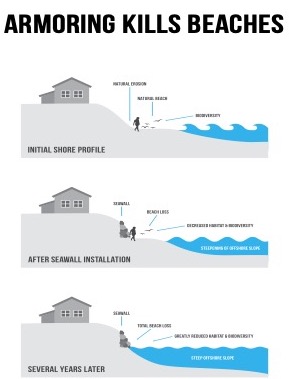
Liminal: relating to a transitional or initial stage of a process; occupying a position at, or on both sides of, a boundary or threshold.
When organizers at San Diego State University called for participation in a new surf conference, “Impact Zones and Liminal Spaces,” your Surfrider California team leapt at the chance to be involved – after all, we spend our work lives defending that "liminal space" between the ocean and civilization, and we do it in spaces that often feel like being stuck in the impact zone. California Policy Manager Jennifer Savage (yours truly), along with California Policy Coordinator Mandy Sackett and Legal Director Angela Howe joined forces to discuss with attendees how we stand to lose our beaches and surf spots – and what can be done to save them.
The liminal space
Think about the beach you love as it exists now. Your favorite surf break. The line which marks the boundary between that which is possessed and that which is not. Wherever the place you picture, our altering of natural interactions between atmosphere and ocean means all our beaches are shifting and, in cases, expected to vanish altogether.
And so the battle between those who hold title to coastal land and those who hold "only" a constitutional right is, like our climate, only getting hotter. The cold hard truth is that, without political action, the phenomenon we call surfing, along with our beaches, may become a thing of the past.
California’s economic health – as the sixth largest global economy, California’s impact on worldwide economic stability must be recognized – depends on saving the state’s coast. That acknowledged, let’s shift to a different kind of health: the kind affirmed in “Blue Mind: The surprising science that shows how being near, in, on, or under water can make you happier, healthier, more connected, and better at what you do,” by marine biologist Wallace J. Nichols. In the book, Nichols offers proven scientific evidence that being close to bodies of water promotes mental health and happiness.
The term “blue mind” describes the mildly meditative state we fall into when near, in, on or under water, validates through science that ocean-induced sensation of calm that moves us to return to the sea again and again, to stay by it, to feel a sense of coming home or, perhaps, to revel in the great mystery, the other-worldness of it.
Blue mind is the antidote to “red mind,” the anxious, over-connected and over-stimulated state that defines the new normal of modern life.
Blue mind is what makes us fall in love with the ocean, is why people gather at the coast and create powerful economies around it. But love alone won’t stop the climate from changing, the sea from rising, the private property owners from building walls at public expense. For that, we need laws and the enforcement of them. Only with the full power of the people and the state, can we draw new lines, in the sand and in our policies, and have a beach, free and open to all, in the future.
Impact Zones
With 2100 as a marker in three recent studies, the U.S. Geologic Survey delivered one gut punch after another:
- 31 to 67 percent of Southern California beaches may completely erode;
- SoCal’s coastal cliffs could recede more than 130 feet;
- Damage from sea level rise could be far more devastating than the worst earthquakes and wildfires in state history.
Sea level rise, in simple terms, would flood out many of our most beloved breaks, permanently. Malibu, the Wedge, Lower Trestles – gone. Any spots dependent on a low tide will disappear when the sea level rises.
“Sea level rise could drown your favorite wave.”
– Ted Reckas, Surfer’s Journal 28.2
Shawn Kelly writes in The Inertia that adding “one to three feet of water over our coastal ocean and surf spots in the next couple of decades to three quarters of a century is going to affect the surf quality… Coastal erosion will likely accelerate surf zones will become narrower and surf-tide relationships will change. All of our surf spots will be affected by the phenomena of coastal squeeze.”
“By 2100 the best conditions experienced…will no longer occur.”
– Dan Reineman, author of "Using local knowledge to project sea level rise impacts on wave resources in California"

Let’s focus on coastal squeeze for a minute: So as sea levels rise, coastal habitats such as wetlands, without any development impediment, would migrate landward – as Kelley puts, they would “roll back” to adjust their position to the best ecological fit for the new sea level. However, most of our coastline is developed and so these fixed man-made structures, especially in the form of seawalls and other types of hard armoring prevent or severely limit this landward movement, which means our beaches cannot, in fact, adapt and are instead squeezed between rising seas and fixed defense lines, increasing the risk that the beach and adjacent coastal habitat may be lost altogether.
“Right now we’re deciding which beaches to save and which ones to allow to disappear with our permitting and planning decisions.”
– Mandy Sackett, Surfrider Foundation California Policy Coordinator
So here we are, with all this fantastic (if depressing) data, much of which is reflected in sea level rise guidance from California’s Ocean Protection Council and California Coastal Commission, two powerful state agencies. And yet, much as data without action is useless, guidance without adherence won’t do anything to save our beaches. This is true in California and everywhere sea level rise is happening… which is everywhere. So how do we manifest all this information into the actual policies that will, if not wholly turn the tide, at least slow the destruction?
California's state agencies are actively working on creative ways to incentivize local governments to plan for sea level rise. Unfortunately, their tools are fairly limited and political support is lacking. The more public education, participation and frankly, outrage, the more we can build political will at the local and state levels to protect public resources. Participation in local planning and permitting is key - elected officials need to hear from you. There is a very strong and vocal "pro-seawalls" movement among beach front and blufftop homeowners but the voice of the beach going public has not been proportionality represented. If we want to turn the tide and save our beaches from sea level rise, we’ll all need to get active!
Contact your local chapter today to find out how to get involved!
